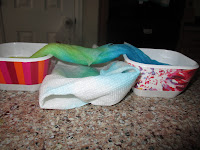Experiment #1: Color Flowers
Materials Needed:
Small white flowers (carnations work best)
Glass containers
Food coloring
Water
We chose three different colors for this experiment. After filling each vase with water the kids squeezed in some food coloring. We then cut the flowers short, stuck them in the water, and waited. I couldn't find white carnations this time around, so I used a bouquet of small white roses instead. The blue color started showing up in the leaves and petals within the first day, the yellow took a bit longer to saturate, and the purple was hardly visible even after several days. We added more water as the level in the vases dropped, but not more food coloring. This was a great way to show kiddos how flowers 'drink' water.
Experiment #2: Paper Towel Color Mixing
Materials Needed:
Small bowls
Water
Food coloring
Paper towel
This super-easy experiment provides quick results and the kids like watching the color soak into the paper towel from different directions. We took one large paper towel and twisted it up like a rope. We then filled each small bowl with water and my daughter chose the colors to add in. We placed one end of the towel into each cup and voila! It was fun to ask Ali what she thought would happen to the water and the towel. She guessed that the water would be soaked up, but didn't think that the colors would mix in the middle. Initially she was correct, but after 30 minutes the colors did meet in the middle and make green.
 |
| Yellow + Blue = Green |



